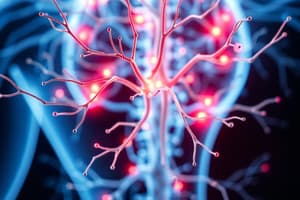Podcast
Questions and Answers
Which of the following best describes the role of A-delta fibers in the pain pathway?
Which of the following best describes the role of A-delta fibers in the pain pathway?
- Relay initial, sharp pain sensations rapidly due to myelination. (correct)
- Responsible for the sensation of deep, visceral pain.
- Primarily involved in the transmission of temperature sensations.
- Transmit dull, aching pain signals through unmyelinated fibers.
In the context of pain assessment using the 'LATERSNAPS' mnemonic, what does 'S' stand for?
In the context of pain assessment using the 'LATERSNAPS' mnemonic, what does 'S' stand for?
- Symptoms (correct)
- Severity
- Supplements
- Stimulus
Which of the following is an example of referred pain according to the information provided?
Which of the following is an example of referred pain according to the information provided?
- Pain felt in the left arm during a heart attack. (correct)
- Sharp pain felt directly at the site of a skin laceration.
- Throbbing pain localized to the site of a muscle strain.
- Burning sensation experienced in the feet due to diabetic neuropathy.
What is the primary role of the somatosensory cortex in pain perception?
What is the primary role of the somatosensory cortex in pain perception?
Which of the following statements accurately describes the role of substance P in the pain pathway?
Which of the following statements accurately describes the role of substance P in the pain pathway?
A patient reports experiencing 'pins and needles' in their lower extremities. According to the pain terminology, this sensation is best described as:
A patient reports experiencing 'pins and needles' in their lower extremities. According to the pain terminology, this sensation is best described as:
According to the information provided, what is a key difference between acute and chronic pain regarding the presence of endogenous modulators?
According to the information provided, what is a key difference between acute and chronic pain regarding the presence of endogenous modulators?
In the context of nociception, what is the immediate consequence if a sensory impulse does not reach the threshold required to trigger an action potential?
In the context of nociception, what is the immediate consequence if a sensory impulse does not reach the threshold required to trigger an action potential?
Which of the following non-pharmacological techniques primarily targets the central nervous system (CNS) to modulate pain perception?
Which of the following non-pharmacological techniques primarily targets the central nervous system (CNS) to modulate pain perception?
What is the role of omega-3 fatty acids in the treatment of inflammation and pain?
What is the role of omega-3 fatty acids in the treatment of inflammation and pain?
Flashcards
Acute Pain
Acute Pain
Normal physiological response to warn of harm.
LATERSNAPS
LATERSNAPS
Follows location, associated symptoms, timing, etc, to understand pain.
Afferent Pathway
Afferent Pathway
Nerve fibers that transmit sensory information from the PNS to the CNS.
Nociceptors
Nociceptors
Signup and view all the flashcards
A or C Nerve Fibers
A or C Nerve Fibers
Signup and view all the flashcards
Sensory Homunculus
Sensory Homunculus
Signup and view all the flashcards
Visceral Pain
Visceral Pain
Signup and view all the flashcards
Cutaneous pain
Cutaneous pain
Signup and view all the flashcards
Dermatomes
Dermatomes
Signup and view all the flashcards
Flexor Withdrawal Reflex
Flexor Withdrawal Reflex
Signup and view all the flashcards
Study Notes
- Pain can be acute, chronic, referred, or neuropathic, involving various nerve fibers and receptors
- Omega 3 fatty acids are often taken as NHPs for inflammation treatment and inhibit the arachidonic acid-conversion pathway
Acute Pain
- Acute pain is a normal physiological warning mechanism
Assessing Pain
- LATERSNAPS mnemonic aids in pain assessment: Location, Associated symptoms, Timing (onset, duration)
- Assess the Mechanism via asking how it started
- Severity can be rated on a scale of 0-10 or with faces tool for pediatrics
- Determine if there are Associated symptoms, such as fever
- Ascertain if the pain is Radiating or is 'referred pain'
Nervous System Communication
- The Central Nervous System (CNS) consists of the brain and spinal cord
- The Peripheral Nervous System (PNS) is the nerve tissue outside the CNS and ENS
- Sensory information travels within the afferent division
- Motor commands travel within the efferent division
- The Somatic Nervous System (SNS) and Autonomic Nervous System (ANS) coordinate motor and sensory information
- Special sensory receptors monitor smell, taste, vision, balance, and hearing
- Visceral sensory receptors monitor internal organs, while somatic sensory receptors monitor skeletal muscles, joints, and skin surface
Nerve Endings
- Different nerve endings are involved in sensing pressure, touch, temperature, and pain
- Pressure-sensitive endings include Pacinian corpuscles and Ruffini's endings
- Meissner's corpuscles and Merkel disks are used for fine touch
- Free nerve endings sense temperature and pain
Afferent Pathway
- Sensory information travels from the PNS to the CNS
- Sensory information starts at the sensory receptor in a specific body part
- Sensory information ends in the CNS's Somatosensory Cortex
- A sensory impulse must be strong enough to reach a threshold for action potential initiation
Nociceptors
- Nociceptors, 1st order neurons (PNS), are located in skin, bones, blood vessels, and visceral organs
- Nociceptors include A or C nerve fibers of the PNS, spinal nerve, dorsal root & ganglion, posterior horn synapse ('substance P' neurotransmitter)
- Signals ascend the spinal cord's white matter column via the 'spinothalamic tract' (lateral)
- Signals then travel to the thalamus ('relay station'), synapse with 3rd order neurons => somatosensory cortex in the brain
Sensory Homunculus
- The sensory homunculus corresponds to specific body parts, and creates awareness
Stimuli
- Large stimuli may trigger many or all receptors, leading to high awareness of pain
- Examples of large stimuli may be trauma such as tissue tearing, involving pressure receptors, free nerve endings and temperature changes in blood
Non-Pharmacological Techniques
- Decreasing inflammation & sensation (PNS): Ice
- Alleviate the trigger (PNS): Massage, Physiotherapy
- Distraction/behaviour modulation (CNS): CBT, Activities
Pain Terminology
- Visceral pain is deep pain, organ-related
- Cutaneous pain is superficial, surface-related
- Referred pain is due to body surface innervation by the same spinal nerve/nerve plexus + interneuron communication
- Reflexes: withdrawal reflex
- Chronic pain is persistent
- Neuropathic pain indicates persistent nerve irritation; difficult to treat
- e.g. allodynia (pain caused by a non-painful stimulus)
- e.g. hyperalgesia (hypersensitivity to a painful stimulus)
- e.g. paresthesias ('pins & needles') and can occur with decreased perfusion of a nerve
- Phantom pain indicates neuropathic pain post amputation
- It is caused by active spinal cord neurons and communicating interneurons despite lack of stimulus
- Often leads to chronic pain
Dermatomes
- Dermatomes are cutaneous segments serviced by spinal nerves and are clinically useful for determining sensory/motor pathways
Reflexes
- Reflex: flexor 'withdrawal' reflex includes stimulus of sharp pain that causes reflex to withdraw without cerebral control
- There is activation of sensory neuron (afferent), interneuron (at level of stimulus in CNS)
- There is automatic activation of a motor neuron (efferent) - response by the effector and the awareness
Acute pain vs Chronic pain
- Acute pain lasts less than 10 days and is self-limiting
- Acute pain triggers endogenous modulators secretion and SNS responses
- Acute pain utilizes an innate protective mechanism and benefits from appropriate treatment
- Chronic pain lasts more than 6 months and travels along C fibres
- Chronic pain causes neurogenic inflammation
- Chronic pain is triggered by under-treated acute pain or chronic inflammatory disorders
- Chronic pain is not self-limiting, lacks endogenous modulators, and has inactive SNS responses
- It is a destructive mechanism and yields dysfunctions
Endogenous Neurotransmitter Modulators
- Endogenous opioid peptides: endorphins, enkephalins, dynorphins
- Serotonin & norepinephrine are released from the CNS, hypothalamus, limbic system, reticular formation
- DESCENDING (efferent) pathways bind opioid receptors to inhibit substance P
- Substance P is an excitatory CNS neurotransmitter which propagates pain input
Pain Gate Theory
- Pain Gate Theory suggests that pain signals are interrupted in the substantia gelitanosa of the spinal cord
Studying That Suits You
Use AI to generate personalized quizzes and flashcards to suit your learning preferences.




